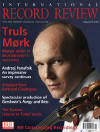Texte paru dans: / Appeared in:
*

International Record Review - (05//2014)
Pour
s'abonner / Subscription information
Accent
ACCSA25318

Code-barres / Barcode : 4015023253186
Since 2006 Sigiswald Kuijken has been leading La Petite Bande through a cycle of Bach cantatas on disc. This does not set out to be a complete cantata cycle; the intention is to record just one cantata for each Sunday and high feast day of the liturgical year, and here with the eighteenth volume of the ongoing series they present three very different ones; for Palm Sunday (BWV182), the sixth Sunday after Trinity (BWV9) and the twenty‑sixth Sunday after Trinity (BWV70).
Recorded in the Predikherenkerk in Leuven, the church's very spacious acoustic wafts over this very closely recorded playing like a vague halo, and the effect is somewhat unnerving ‑ it's as if we are up in the gallery in the midst of the musicians physically involved in the performance, rather than below in the body of the church fulfilling the role of interested observers. At times that does give a somewhat distorted view of the music. We seem disproportionately close to the lower instruments, with the bassoon of Rainer Johanssen almost right in our ear for the tenor aria 'Hebb euer Haupt empor' from BWV70, and Christopb Genz glimpsed aurally, as it were, as if over the heads of the assembled instrumentalists. Jan Van der Crabben has a similar issue in the following recitative ('Ach, soll nicht dieser'), where the bassoon throbs with a vivid physical presence and even the magisterial trumpet of Jean François Madeuf seems strangely remote.
Once used to this peculiarly intimate aural vantage point, the real beauty of this musicmaking is immediately apparent, as is the extreme attention to every tiny detail which characterizes Kuijken's whole approach. That attention to detail manifests itself most obviously in the vast swathes of written material which accompanies the disc. We have not one but two closely printed booklets, the first (of 28 pages) devoted to an extensive listening guide (headed 'Getting the best from listening to the Bach cantatas'), which includes the admonition to read the texts and consider them 'as dispassionately and openheartedly as possible before listening to, each work'. I regret that I have not taken Kuijken's advice, but since the texts are analysed and described in exhaustive detail later in the booklet, I feel I know them as intensely as I could ever want. The other booklet (64 pages long) provides what I can only describe as an in‑depth analytical survey of the three cantatas performed on the disc along with, of course, their texts and translations (buried deep in the booklet). The only thing missing is a detailed track list: that finds itself crammed on to the back of the three page fold‑out CD cover.
Fortunately, while the performances themselves are clearly the result of intense and painstaking preparation, the music is rarely obscured by an excess of scholarly pedantry. Kuijken is clearly committed to the concept of the cantatas being performed with one voice and one player to a part (only the violins and violas occasionally double up) and while that does make for some wonderfully intimate music‑making, the vocal parts are rather swamped by the instrumental support in the chorales. This quartet of soloists, too, do not always gel convincingly as a choir, and, in ensemble, both Gerlinde Sämann and Van der Crabben seem largely unaware of the presence of either Petra Noskaiová or Genz.
This is, in any case, a somewhat uneven vocal line‑up, and in these three cantatas the female voices are, with the exception of a duet in Es ist das Heil uns kommen her, confined to the chorus. In that duet (Herr, du siehst statt') Sämann oozes purity and charm, against the rather more earthy quality of Noskaiová. Genz delivers his arias with great aplomb ‑ 'Jesu, lass durch Wohl und Weh' from Himmelskönig, sei willkommen a rare moment of vivid drama, heightened by a breathlessly athletic Kuijken playing an even rarer violoncello da spalla ‑ but, while he is a solid bass in ensembles, I find Van der Crabben a somewhat leaden soloist, especially when the string support to his BWV182 aria Starkes Lichen' is so delicately effusive.
The orchestral
playing is invariably excellent, with several moments of utter enchantment.
The opening chorus of BWV9, with its bubbling flute and oboe (Bart Coen and
Emiliano Rodolfi respectively) providing a charming escort to the floating
(if aurally distant) voice of Sämann, is one. But possibly the most
arresting of these comes with the Sinfonia to BWV182, a delicious duet
between recorder and violin with some beautifully buoyant orchestral
support. Kuijken suggests that the opening of BWV182 evokes the faintly
ridiculous image of a great king riding on a humble donkey, and this
performance certainly captures the eccentricity of that imagined scenario;
this continues into the jaunty opening chorus which Kuijken perfectly
describes as 'madrigalesque'.
Cliquez l'un ou l'autre
bouton pour découvrir bien d'autres critiques de CD
Click either button for many other reviews


